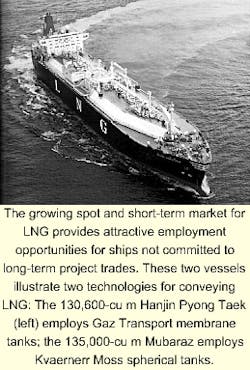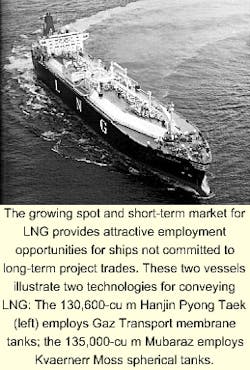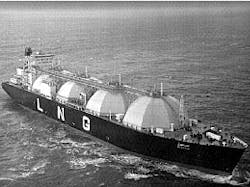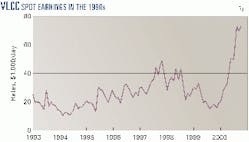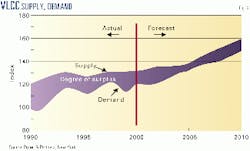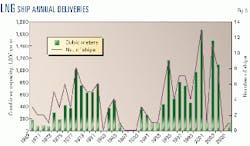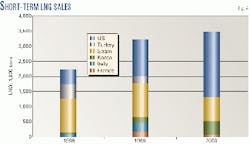Events of the past year have surprised oil tanker owners and charterers alike with higher-than-expected rates.
At the same time, a fundamental shift under way in the utilization of LNG shipping signals that those vessels are leaving their traditional role as an integral part of a project.
These are the major conclusions of a yearend analysis of oil and LNG shipping by world shipping consultant Poten & Partners, New York.
Record levels
Tanker owners and charterers alike have been surprised in 2000 with tanker rates across most vessel sizes rising to record levels. This was unexpected. But external events have occurred that were not in most outlooks.
Key among these events was the sinking of the Erika in December 1999.
The incident was one of a number of maritime incidents that have brought changes to oil-pollution liability and vessel construction standards such as MARPOL (Marine Pollution) 73/78 International Convention and the US Oil Pollution Act of 1990.
(Editor's note: MARPOL 73/78 is the International Convention for the Prevention of Pollution from Ships, 1973, amended by a subsequent Protocol, 1978.)
Among other things, these accords affect long-term tanker supply by gradual phasing out single-hull tankers, giving the shipping industry about 2 decades to adjust.
The Erika incident had an immediate impact on short-term tanker supply. Many oil-company chartering managers, under pressure from senior management, have switched their preferences to younger vessels. This has had the effect of restricting the available supply of vessel capacity to vessels 20 years old or younger.
In the case of the very large crude carrier (VLCC) fleet, 140 out of 430 vessels (about one third) are 20 years old or older.
The second underlying cause for the current high tanker rates has been increased oil demand between 1999 and 2000. Commonly accepted wisdom was that oil demand would grow modestly as the Far East nations grappled with the aftermath of the Asian flu.
But those Far East nations most affected by the economic turndown (Korea, Thailand, Malaysia, and Philippines) are experiencing a robust economic recovery. Moreover, China is emerging as a major oil importer.
Given this increased economic activity, it is not surprising that the number of oil shipments on spot market VLCCs has risen by more than 30% in 2000. This was not only to meet increased demand, but also to better expand inventory to match this higher level of consumption.
The voluntary diminution of tanker supply accompanied by increasing tanker demand has pushed up tanker rates (Fig. 1).
In addition to its short-term impact, the Erika incident has spurred introduction of proposals to accelerate the phase-out provisions of MARPOL 73/78. Enactment of any one of these proposals in its current form will have a significant long-term impact on tanker supply and on VLCC rates (OGJ, Nov. 20, 2000, p. 68; Dec. 4, 2000, p. 96).
The major change in formulating overall VLCC demand is abandonment of the traditional exercise of netting Atlantic basin consumption with Atlantic basin production to obtain Arabian Gulf exports to the US. Events over the last few years have shown that Saudi Arabia is not going to be displaced in the US market.
Thus, forecast VLCC demand is based on a continued presence of Saudi Arabian crude in the US market coupled with excess Atlantic basin crude being exported to Asia as backhaul cargoes on VLCCs.
This does not put the importer in China or exporter in West Africa at any shipping-cost disadvantage. Most VLCC owners are willing to offer lower rates for these backhaul cargoes because they significantly increase vessel earnings by reducing the distance of ballast voyages.
The supply-demand balance shown in Fig. 2 reflects demand utilizing the new model for growing Atlantic basin oil flows to Asia and the impact of the Erika incident in phasing out older single-hull tankers.
By any measure, these changes will con tinue to improve the VLCC tanker rate forecast.
Fundamental change
The LNG shipping business, known for its conservative practices, is undergoing some very fundamental changes in how ships are viewed and used in the business.
A growing short-term LNG business is creating new business opportunities and forcing the industry to re-evaluate the traditional role of LNG ships.
In the traditional LNG business, ships are ordered only after long-term LNG sales have been contracted and a specific ship route and requirement are fully defined. Ships are sized, designed, and optimized to transport contract quantities of LNG on a specific route.
After the ship is delivered, it is expected to commence operation under a long-term charter or transportation agreement and serve exclusively on a dedicated route. Based on the secure long-term charter income, financing could be arranged on a limited recourse basis.
As a result, LNG ships were seen as belonging to a project and were only one more costly item in a chain of expensive facilities dedicated to servicing a specific LNG contract.
Now, Poten & Partners sees this view of ships is changing fundamentally as the LNG business also changes. Evidence of this change can be seen from a pattern of recent events:
- The LNG fleet size has increased by 20% in the past 2 years.
- The number of existing LNG ships without long-term employment commitments dropped from 19 vessels in early 1999 to 7 vessels by 2000.
- New LNG ship prices have dropped by nearly 50% in 10 years.
- There are currently 21 ships on order, with options for 8 more ships to be delivered in the coming 3 years.
- Of 29 ships on order and under option, 20 have no specific employment.
The LNG fleet consisted of 125 vessels as of Oct. 1, 2000. Fig. 3 shows the number of ships and combined LNG capacity of LNG ships delivered each year since 1969.
Of these ships the vast majority, about 119, are committed under long-term charter arrangements that ensure employment but largely limit where they will trade.
In 1999 and 2000, 21 new ships were delivered, increasing the fleet size by 20% in only 2 years. The overall size of the LNG business is increasing, but shipping is growing even faster because shipping distances from new LNG sources to their buyers are longer than earlier projects.
In 2001-2003, another 20 ships will be delivered, further increasing the LNG fleet by 16%. In addition to ships on order, owners have options to have an additional 6 ships constructed for delivery in 2003 and another 2 in 2004.
In a major departure from the traditional LNG business just described, 13 of the ships with firm orders and all 7 of the ships on option in the 2001 through 2003 period will be built without firm employment on a long-term trade.
What would cause owners to take this bold step when even at today's reduced prices, a new LNG ship costs more than $170 million after finance during construction, supervision, and outfitting?
One reason is greatly reduced newbuild prices. A decade ago, new ships cost more than $260 million, which equals more than $300 million in 2000 dollars. With lower ship prices, owners apparently see an opportunity to purchase LNG ships at prices that will only increase in the future.
A second factor is that the number of existing ships not committed to long-term trades is dwindling. Today about 7 ships are not committed, but that number will decrease when expansions of existing projects commence operation in 2002-2003 and charters to existing projects and buyers commence.
Short-term market
Poten & Partners believes, however, that the major factor would seem to be the growing spot or short-term market for LNG, which provides attractive employment opportunities for uncommitted ships.
As shown in Fig. 4, the short-term LNG market has grown to more than 3 million tons/year. While it is only about 3% of the worldwide LNG trade, it has growing significance in a long-term oriented business.
The basis of short-term trades is the availability of uncommitted supplies, unfilled market demand, and ships to transport LNG from the seller to buyer.
Most LNG plants in the world have surplus LNG production capacity. Surplus capacity has increased in recent years when LNG plants commenced operation with only part of their rated capacities sold.
Therefore, there is ample surplus capacity to double or even triple short-term trade.
Traditional buyers appear to be using short-term supplies as a small but growing part of their overall supply portfolio. More important is the vast US gas market where LNG cargoes can be sold on short notice.
Current high prices in the US and the planned reopening of the Elba Island, Ga., and Cove Point, Md., import terminals make this an appealing market.
The final link in the LNG value chain is shipping, which currently is the bottleneck in short-term LNG business.
Until late 1999, there were several uncommitted ships. Atlantic LNG of Trinidad and Tobago and Nigeria LNG (NLNG), however, commenced commercial operations in 1999, using existing ships.
Atlantic LNG's buyers, Enagas and Cabot LNG, used four existing ships to meet their FOB lifting requirements. NLNG's shipping subsidiary, Bonny Gas Transport, purchased four existing ships and chartered in three more ships to fulfill its transportation requirements.
This reduced the number of uncommitted ships to eight ships, but several of these have long and medium-term commitments for the future.
Owner positions
It is this combination of factors that encouraged ship owners to purchase new ships without long-term employment. While the ships do not have guaranteed employment, some of the owners have significant LNG positions that make these ships far from speculative.
- Shell ordered two ships from Mitsubishi Heavy Industries, one for delivery in 2002 and the second in 2003. The ships are not committed to a specific trade, but Shell could find many employment opportunities given its LNG activities.
On the supply side, Shell is an equity participant in five operating liquefaction plants. Two are currently being expanded, and there are plans to expand the other three, expansions that will bring surplus cargo.
Shell is also interested in purchasing the "wedge" volumes that will be available from the Australia North West Shelf expansion, where it holds a one-sixth interest. ("Wedge" refers to the difference between expected plant capacity and contractual offtake volumes by buyers.)
On the demand side, Shell's Coral Energy affiliate has reserved approximately 2 million tons/year of import and regasification capacity at the Cove Point terminal.
Shell also has proposed to open an LNG import facility at the port of Hazira in Gujarat State in western India.
- BP placed two firm orders and has three options from the Samsung shipyard in Korea. Again the ships are not committed to a specific trade and BP has said that the ships are being built to create liquidity in the LNG shipping market.
On the supply side, BP is an equity participant in four LNG plants, and all have surplus capacity. Two of the plants are being expanded, which is likely to create surplus capacity.
BP is also actively seeking to purchase the surplus capacity (wedge volume) from the planned expansion of Australia's North West Shelf LNG, where it holds a one-sixth interest.
On the demand side, BP reserved approximately 2 million tons of import and regasification capacity at the Cove Point terminal.
In addition, BP is part of a consortium that will construct an LNG import terminal and a gas-fueled power plant in northwest Spain.
- Tokyo Gas Co. Ltd. ordered two LNG ships from Kawasaki Heavy industries, but these can hardly be considered speculative orders.
Tokyo Gas will purchase LNG from Australia's North West Shelf expansion on an FOB basis and use one of its ships to transport this LNG.
A portion of the LNG that Tokyo Gas will purchase from the new MLNG Tiga project, Malaysia, will be on an FOB basis and will require some ship capacity.
- Tokyo Electric Power Co. is reported to be considering the purchase of an LNG ship to move some of its FOB-contract purchases.
- Petronas Tankers ordered four ships from Mitsubishi Heavy Industries and Mitsui Engineering & Shipbuilding in Japan and has options for two more ships.
Petronas is the shipping side of the Malaysian LNG business, and the four ships complement the two-train LNG MLNG Tiga plant that is under construction at Bintulu.
Petronas Tankers will transport MLNG Tiga ex-ship sales volumes of 1.2 to 1.7 million tons/year that are under a Confirmation of Intent with Japanese buyers.
Petronas Tankers will also be involved in transporting LNG for the ex-ship sales from MLNG Tiga to Metropolis Gas, an Enron subsidiary in India.
- Bergesen, Exmar, and Naviera Tapias are traditional shipowners, and do not have the same LNG assets and positions as the owners previously mentioned. These owners will employ their ships under long-term charters to LNG sellers or buyers.
Control of ships
In the new and evolving LNG business, control of LNG ships is strategic.
Control of ships allows supply projects to commit before all of the LNG is sold under long-term contracts because surplus capacity can be transported to and sold into short-term markets.
Control of ships allows the buyers to purchase short-term quantities that are needed to add annual and seasonal flexibility to their supply portfolios.
The authors
Jeffrey Goetz joined Poten & Partners in 2000 to head marine consulting, a newly formed group within the tanker department.
Formerly, he was a senior analyst in marine planning at ExxonMobil Corp. Goetz holds a BS from the US Merchant Marine Academy, Kings Point, NY, and an MBA from Columbia University, New York City.
Roy Nersesian has been with Poten & Partners since 1977. He is editor of the firm's tanker market monthly and contributes to numerous Poten studies, forecasts, and analyses. He is also professor and chair of management department at Monmouth University, School of Business Adminis tration, West Long Beach, NJ. Previously, he served as advisor on shipping loans to chief lending officer of Manufacturers Hanover Trust Co. and was a project analyst with Zapata Naess Shipping Co., both companies of New York City. Nersesian holds a BS in physics from Rensselaer Polytechnic Institute, Troy, NY, and an MBA from the Harvard Business School.
Frederick R. Adamchak joined Poten & Partners in 1995 as manager of the LNG consulting group. Previously, he was with Marathon Oil Co., Houston, as senior petroleum engineer (1981-1985), manager of LNG operations (1985-1987), and manager of international natural gas (1987-1995). He was with the US Coast Guard as shipboard engineer and marine inspector of commercial vessels (1969-1979) and chief of chemical engineering branch at Coast Guard headquarters, Washington, DC (1979-1981). Adamchak holds a BS in engineering from the US Coast Guard Academy, New London, Conn., and an MS in chemical engineering from the University of Maryland, College Park.
Gabriel Avgerinos has been with Poten & Partners since 1981. He is general manager of the gas and LNG consulting group and served as manager of energy consulting, 1984-94. Previously, he was with Exxon Chemicals, 1975-1981 and Esso Chimie SAF, France, 1976-77.
Avgerinos holds a BS in chemical engineering from the Polytechnic Institute of New York, New York City; an MS in chemical engineering from Massachusetts Institute of Technology; and an MBA in international marketing from New York University, with studies at the Hautes Etudes Commerciales (France) and the London Business School.
